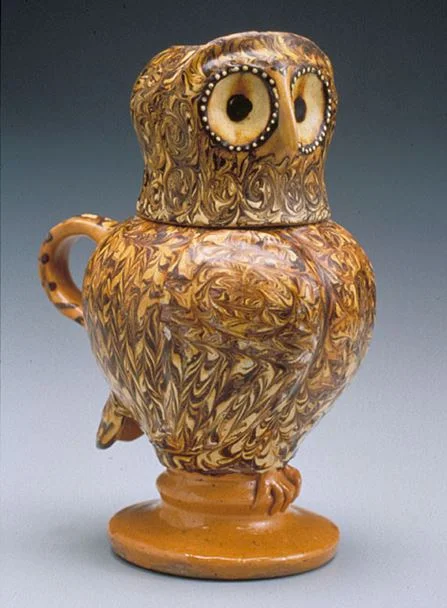Michael Gates (NC)
Michael's Statement
For The Last Drop Project, I chose to work on a reinterpretation of The Chipstone Foundation’s Staffordshire slipware owl drinking vessel. It seemed to be a natural choice as I have been using lots of slips and some underglazes in my work recently. I decided to stay somewhat close to the basic form of the Staffordshire owl with some changes such as adding a handle to the mug/lid and making it footed to allow for the top of the owl’s head to be glaze covered. I also changed the shape to make it a more flowing form and made it oversized. I attached flattened clay tabs for feathers to make the wings and tail stand out more. I couldn’t resist a little sculptural work on the owl’s face to make it more owl-like and of course a mustache! The surface of the body, I planned to use as a canvas to explore the complex subject of alcohol in the twenty-first century.
The number “21” kept turning up as I took a look back alcohol consumption in the US over the past century. The twenty-first century has seen lots of changes with prohibition and the 21st amendment repealing it. Problems with underage drinking seemed to increase with the drinking age being raised from 18 to 21. This made alcohol a forbidden fruit and more interesting to the youth, causing an underage binge drinking problem in the US. Countries with more relaxed laws or no laws on the subject have not had the same problems. I slip trailed ‘forbidden fruit’ in the front of the vessel, along with ‘century’, ‘age’, ‘amendment’, and even ‘blackjack’ as references to the big ‘21’. An outline of black underglaze gave a little more of a pop.
The symbolic wise old owl seems an appropriate one to comment on the ritual use of alcohol throughout history. Evidence that the need to transcend everyday life through intoxicants such as alcohol has been found throughout history. The owl may have once been asked, “How many drinks does it take to get to the center of one’s self?” The world may never know but I imagine the wise old owl would stress moderation in all things including alcohol. Under the owl’s beak, I wrote in a light-colored slip the word ‘moderation.’ However, with such a large oversized drinking vessel the owl could have easily been giving a wink, wink. I can tell you from personal experience that moderation in drinking is very important to remember while working with clay. Alcohol can be a great uniter that helps people open up socially and make great connections with others, but excess can also be a great destroyer of relationships and health. I have seen this first hand with the loss of two of my closest friends due to alcohol-related health problems. I thought some about this dualistic nature of alcohol in American society while working on the project.
Many people have enjoyed the craft beer revolution of the 21st century. It was sparked when Jimmy Carter legalized home brewing in 1978, and the craft renaissance shifted into full throttle early in the 21st century. I decided to paint a large ‘21’ in slip on the front of the vessel along with hops buds and a vine running and curling throughout. Also scattered a few brewing terms, some barley, and ingredients throughout creating an elaborate and busy surface design in an effort to represent the complexity of craft brewing today. With a greater variety of hops and malt and combinations with fruit, grain, herbs, flowers and techniques, a brewer today can create any type of beer they want. The possibilities are endless just like they are when you have a ball of clay in front of you. The art of craft brewing has emerged with lots of creative possibilities. As an occasional bartender somewhat of a beer connoisseur, this facet of alcohol in the twenty-first century seemed to be the most radically changing, and an obvious choice to include on the vessel.
With the amount of slip and underglaze on the piece, I needed to use a transparent glaze and lots of control in the firing process. Therefore, I glazed with a thinned Alberta slip and a coat of clear over it and fired mid-high temperature in the electric kiln. The result was a graphically strong piece with lots of highly visible detail to convey my ideas.
Michael's Bio
Traditional elements from the 1800s and forward in the Catawba Valley, North Carolina area have influenced my forms, glazes, clays, process, and decoration. Elements of the Reinhardt lineage of potters in my family, specifically, have made their way into my more contemporary work. However, with less importance on making functional ware as they did in this pre-industrialized era, I have the luxury to spend more time on decoration, concept, and the whimsical. I have an affinity for making the traditional family pieces in the traditional way, yet I also enjoy making something that’s new and different. Combining the two is what I enjoy the most about my work.

21st Amendment Owl Jug
Michael Gates, 2017. Elk Park, NC. H. 22½”.
This is the piece Michael created for THE LAST DROP: INTOXICATING POTTERY, PAST AND PRESENT.

Owl Jug and Cup
Staffordshire, England, ca. 1690-1700. Slip-decorated earthenware. Chipstone Foundation. H. 9 1/8”
This the historical piece from which Michael chose to draw inspiration.